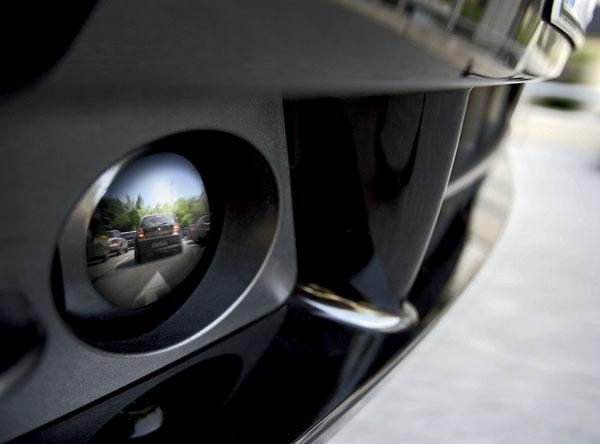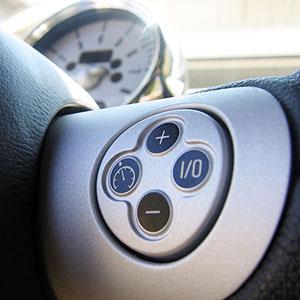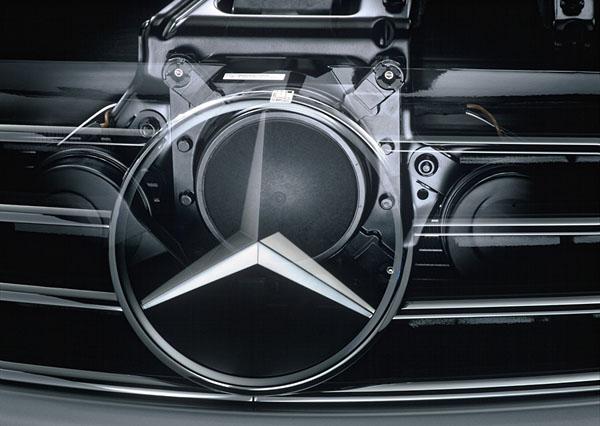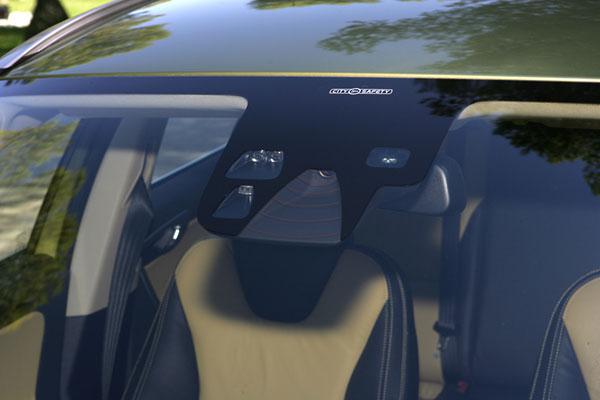Remote superintendent
 Bashny.Net
Bashny.Net
On-board electronics of the car is ready to take the situation under control, but not yet ready to take responsibility.
Active cruise control once invented to reduce the number of actions taken by the person behind the wheel. So was the first step on the road to cars that do not need a driver.
5 photo + letter
Alexander via Korobchenko.
1. Thanks to the active safety systems, which are installed on modern cars, the driver is required less and less action. Active cruise control can itself control the speed of the car not only on motorways, but also in urban traffic. Photo: BMW AG

Science fiction writers of the last century and had no idea that the movement of the driver to turn into pure passive formality can be so soon. However, before the advent of unmanned vehicles we still have a little time. "By developing active safety systems, we are guided by the main principle - these systems do not have to take control of the vehicle or replace the driver", - says Silvia Güllsdorf (Silvia Gullsdorf), director of the project S80 Volvo Cars.
The laws of the market require producers to make safe, powerful, comfortable and fuel-efficient vehicles at the same time .... Ten years ago, all four components are not physically able to be combined in one machine - a maximum of three satisfied. Today, "four in one" - a reality. And a major role in this was played by the development and improvement of active safety systems, ie devices that can prevent an accident. Normal cruise control - a system of automatic speed - to those not classified. But the active cruise control is quite deserved. Once in America
For the first time on a production car cruise-control appeared in 1958 in the US Chrysler Imperial. The system reads the rotational speed of the propeller shaft and controlling the flow of fuel into the combustion chamber. Thus, the driver is no need constantly to press on the gas pedal to keep a constant, "cruising" speed ("cruising" in English sounds like «cruise», «cruise»).
Cruise control is especially good on the long empty roads, especially on American roads connecting states. But in heavy traffic when cars are moving at different speeds, the driver does not relax. And each press of the brake pedal is sure to disable the system. This problem has given designers an occasion to reflect and develop a system that would not disturb the person behind the wheel every time there is an obstacle ahead. Fantastic? Certainly not!
2. American Chrysler Imperial 1958 - the first production car, which was mounted cruise control

Already in 1998 at the luxury sedan Mercedes-Benz S-Class appeared active (adaptive) cruise control Distronic, can recognize cars going ahead and reduce speed by keeping a safe distance. But the first version had a range of only 80 meters and could not re-accelerate the vehicle after the obstacle has disappeared from sight, and did not provide braking to a full stop.
Almost simultaneously with the Mercedes flagship similar systems acquired premium brands: BMW seventh series, Audi A8, Jaguar XJ. And three years later, was a landmark event. The company FIAT launched the compact Fiat Stilo (hatchback Golf-class), which was equipped with the optional active cruise control. Thus, with the new millennium, even the owners of small and not very expensive models were able to enjoy the privileges of luxury cars: move in a lively stream and provide electronic acceleration and braking.
In 2010, the number of automotive companies using active cruise control, increased several times. Changed and the systems themselves: increased range of the distance sensors, has expanded the range of supported rates, improved "mutual understanding" on-board automotive electronics and directly "brains" electronic "supervisor" distance. Light or sound?
Active cruise control consists of an electronic control unit and one or more sensors that determine the position and velocity of the surrounding objects. The unit analyzes the speed and distance to the front walking facilities managed vehicle speed, curve radius, steering angle, lateral acceleration, and many other parameters. Furthermore, in accordance with this information, the control unit makes corrections to the engine, brakes, transmission, the auxiliary electronics and the need for - and other components of a vehicle.
Tracking system ahead going transport, there are many, but the defining difference between the two - in distance sensor. The sensors can be operated on the principle of radar or lidar optical analogues (LiDAR). The principles of operation of the first and second are very similar: radiated electromagnetic waves are reflected from the object and recorded the receiving antenna, the time delay of the reflected signal and change its spectrum calculated the distance to the object and its speed. Advantages of such devices are in range, wide field of view and the ability to operate under difficult weather conditions. The adaptive cruise control radar used by companies Continental, Delphi, Mitsubishi Electric, Elesys, Tyco Electronics and Bosch.
LIDAR measures the distance based on the time needed for flight of the laser beam to the object and back. A short pulse of infrared light coming from the source is reflected from the object and recorded electronics. In the automotive industry the advantages of radar lidar - less exposed to precipitation and greater reliability. The actual lack of one - the higher cost. Lidars use the same Continental, Omron Automotive, Hella.
3. Use the cruise control is quite simple, you need only to press a couple of buttons on the steering wheel, thereby setting the desired speed. Photos (Creative Commons license): Dylan Ashe
Dobavleno1 in [mergetime] 1276782739 [/ mergetime]
Manual
Using adaptive cruise control is as simple as usual: first, the driver needs to start speed dial - most systems start to work with the 30-40 km / h. Then you need to turn on the system and bring it to the "alert" by pressing the appropriate button on the steering wheel, steering column lever or a separate remote control - depending on where the manufacturer deems it necessary to place it. Then you need to get up to speed movement or by means of the accelerator pedal or by pressing another button Cruise Control - «Accelerate», «Acceleration" (usually abbreviated to write «Accel»). Now the right foot may rest. When the arrow (or digital display), the speedometer will show the desired speed, press the «Set» - «install». Everything is now set speed.
There is a logical question: what is the difference between adaptive and "classic" cruise control? In anything, as you move along the empty road or try to make adjustments to the algorithm of the system. But in the "Settings" adaptive QC can specify the distance to the vehicle in front, where the driver intends to stay away from other road users.

Unlike modern systems of active cruise control from the first versions of the ability of the electronics to control the movement not only at high speed in the highway, but in the dense urban bustle. This was made possible thanks to the fact that, in addition to "long-range" Distance sensors in the system began to integrate short-range devices and tracking objects at a distance of several tens of centimeters.
Take as an example a system of active cruise control Distronic, installed into cars Mercedes-Benz. Walking distance to objects in front of the ultrasonic sensor monitors running at a frequency of 77 GHz. To control the objects that are closer than 30 meters, in the Mercedes used radar neighbor "battle", using the frequency of 24 GHz (these sensors have appeared in the new generation of active QC - Distronic Plus). It is through these radars cars trёhluchevoy star "learned" to keep a distance not only on the track but also in the city and even in traffic jams.
But here's the problem lies operation of such devices in the Russian conditions: a range of short-range radar Mercedes (and many other similar systems) occurs at a frequency reserved radio astronomy and radar services. In addition, the unfortunate incidence falls on the operating channels of police speed measuring devices (they operate at a frequency of 24 to 150 GHz), and to a range of illegal (but used) means to combat them - "radar detector" and "radar detectors».
4. System DISTRONIC by car "Mercedes" maintains a desired distance to the vehicle ahead. If the distance decreases, the brake system is activated. If you are not going to come any car, the driver DISTRONIC maintains the set speed. Photo: Daimler AG
Dobavleno1 in [mergetime] 1276782808 [/ mergetime]
In this regard, the Russian cars are not equipped with active cruise control a number of big-name automakers worldwide; and the company's Mercedes, for example, have to put on our machines of the previous generation system Distronic radar extremely long range. But Audi does not have any problems with our legislation: their radars operate at a frequency of 200 GHz, and do not interfere with either the radiolocation service, nor the Interior Ministry. No problems with the law and Infiniti: Active Cruise Control ICC, designed by Japanese engineers, uses lidar sensors, so - does not take a radio frequency.

The human factor
Today, almost all major car manufacturers have to their credit cars equipped with active cruise control. It is easier to list Do not use the sensor distance. Nowadays, this kind of device went beyond the bounds of "favors" and became a reference point for the emergence of a number of other auxiliary systems. Those radar and lidar sensors are used in the control module for road markings, help with parking (including help to find the car and take place almost without the help of the driver), see people and animals in the dark, read the road signs. If all of these systems will find a common language with the on-board electronics of the car (partly already happening), "make friends" with accurate maps and GPS-navigation, the man will only choose from the drop-down list of the destination and click "OK" on the monitor from the back seat.
But while not without embarrassing blunders. In mid-May 2010 Online walked unusual video. It was filmed by one of the journalists at the launch of Volvo, the press is going to demonstrate the security of its new sedan S60. Creators proudly declares about the car as the safest in the world, but that's a Swedish court forbade the company to quickly make such bold statements without good reason. And, to the surprise of the automaker, the presentation itself is only confirmed.
The new Volvo S60, which was not the driver accelerated to 35 km / h and was sent to the stands side of the truck. Installed in the car active cruise control should stop the vehicle immediately prior to contact. But before dozens of pairs of eyes and a dozen lenses, waiting for a small technological miracle, ordinary accident happened: passenger car simply "imprinted" in the truck. Later, representatives of Volvo explained the incident to human factors engineering unlucky simply forgot to charge the battery, so the system never worked. Because of such incidents, many are still cautiously waiting for times when the computer will assume excessive responsibility for human life.
5. Volvo XC60. Sensors and a camera mounted at the top of the glass Lobo. Photo: Volvo Car Corporation

Source:
Active cruise control once invented to reduce the number of actions taken by the person behind the wheel. So was the first step on the road to cars that do not need a driver.
5 photo + letter
Alexander via Korobchenko.
1. Thanks to the active safety systems, which are installed on modern cars, the driver is required less and less action. Active cruise control can itself control the speed of the car not only on motorways, but also in urban traffic. Photo: BMW AG

Science fiction writers of the last century and had no idea that the movement of the driver to turn into pure passive formality can be so soon. However, before the advent of unmanned vehicles we still have a little time. "By developing active safety systems, we are guided by the main principle - these systems do not have to take control of the vehicle or replace the driver", - says Silvia Güllsdorf (Silvia Gullsdorf), director of the project S80 Volvo Cars.
The laws of the market require producers to make safe, powerful, comfortable and fuel-efficient vehicles at the same time .... Ten years ago, all four components are not physically able to be combined in one machine - a maximum of three satisfied. Today, "four in one" - a reality. And a major role in this was played by the development and improvement of active safety systems, ie devices that can prevent an accident. Normal cruise control - a system of automatic speed - to those not classified. But the active cruise control is quite deserved. Once in America
For the first time on a production car cruise-control appeared in 1958 in the US Chrysler Imperial. The system reads the rotational speed of the propeller shaft and controlling the flow of fuel into the combustion chamber. Thus, the driver is no need constantly to press on the gas pedal to keep a constant, "cruising" speed ("cruising" in English sounds like «cruise», «cruise»).
Cruise control is especially good on the long empty roads, especially on American roads connecting states. But in heavy traffic when cars are moving at different speeds, the driver does not relax. And each press of the brake pedal is sure to disable the system. This problem has given designers an occasion to reflect and develop a system that would not disturb the person behind the wheel every time there is an obstacle ahead. Fantastic? Certainly not!
2. American Chrysler Imperial 1958 - the first production car, which was mounted cruise control

Already in 1998 at the luxury sedan Mercedes-Benz S-Class appeared active (adaptive) cruise control Distronic, can recognize cars going ahead and reduce speed by keeping a safe distance. But the first version had a range of only 80 meters and could not re-accelerate the vehicle after the obstacle has disappeared from sight, and did not provide braking to a full stop.
Almost simultaneously with the Mercedes flagship similar systems acquired premium brands: BMW seventh series, Audi A8, Jaguar XJ. And three years later, was a landmark event. The company FIAT launched the compact Fiat Stilo (hatchback Golf-class), which was equipped with the optional active cruise control. Thus, with the new millennium, even the owners of small and not very expensive models were able to enjoy the privileges of luxury cars: move in a lively stream and provide electronic acceleration and braking.
In 2010, the number of automotive companies using active cruise control, increased several times. Changed and the systems themselves: increased range of the distance sensors, has expanded the range of supported rates, improved "mutual understanding" on-board automotive electronics and directly "brains" electronic "supervisor" distance. Light or sound?
Active cruise control consists of an electronic control unit and one or more sensors that determine the position and velocity of the surrounding objects. The unit analyzes the speed and distance to the front walking facilities managed vehicle speed, curve radius, steering angle, lateral acceleration, and many other parameters. Furthermore, in accordance with this information, the control unit makes corrections to the engine, brakes, transmission, the auxiliary electronics and the need for - and other components of a vehicle.
Tracking system ahead going transport, there are many, but the defining difference between the two - in distance sensor. The sensors can be operated on the principle of radar or lidar optical analogues (LiDAR). The principles of operation of the first and second are very similar: radiated electromagnetic waves are reflected from the object and recorded the receiving antenna, the time delay of the reflected signal and change its spectrum calculated the distance to the object and its speed. Advantages of such devices are in range, wide field of view and the ability to operate under difficult weather conditions. The adaptive cruise control radar used by companies Continental, Delphi, Mitsubishi Electric, Elesys, Tyco Electronics and Bosch.
LIDAR measures the distance based on the time needed for flight of the laser beam to the object and back. A short pulse of infrared light coming from the source is reflected from the object and recorded electronics. In the automotive industry the advantages of radar lidar - less exposed to precipitation and greater reliability. The actual lack of one - the higher cost. Lidars use the same Continental, Omron Automotive, Hella.
3. Use the cruise control is quite simple, you need only to press a couple of buttons on the steering wheel, thereby setting the desired speed. Photos (Creative Commons license): Dylan Ashe
Dobavleno1 in [mergetime] 1276782739 [/ mergetime]
Manual
Using adaptive cruise control is as simple as usual: first, the driver needs to start speed dial - most systems start to work with the 30-40 km / h. Then you need to turn on the system and bring it to the "alert" by pressing the appropriate button on the steering wheel, steering column lever or a separate remote control - depending on where the manufacturer deems it necessary to place it. Then you need to get up to speed movement or by means of the accelerator pedal or by pressing another button Cruise Control - «Accelerate», «Acceleration" (usually abbreviated to write «Accel»). Now the right foot may rest. When the arrow (or digital display), the speedometer will show the desired speed, press the «Set» - «install». Everything is now set speed.
There is a logical question: what is the difference between adaptive and "classic" cruise control? In anything, as you move along the empty road or try to make adjustments to the algorithm of the system. But in the "Settings" adaptive QC can specify the distance to the vehicle in front, where the driver intends to stay away from other road users.

Unlike modern systems of active cruise control from the first versions of the ability of the electronics to control the movement not only at high speed in the highway, but in the dense urban bustle. This was made possible thanks to the fact that, in addition to "long-range" Distance sensors in the system began to integrate short-range devices and tracking objects at a distance of several tens of centimeters.
Take as an example a system of active cruise control Distronic, installed into cars Mercedes-Benz. Walking distance to objects in front of the ultrasonic sensor monitors running at a frequency of 77 GHz. To control the objects that are closer than 30 meters, in the Mercedes used radar neighbor "battle", using the frequency of 24 GHz (these sensors have appeared in the new generation of active QC - Distronic Plus). It is through these radars cars trёhluchevoy star "learned" to keep a distance not only on the track but also in the city and even in traffic jams.
But here's the problem lies operation of such devices in the Russian conditions: a range of short-range radar Mercedes (and many other similar systems) occurs at a frequency reserved radio astronomy and radar services. In addition, the unfortunate incidence falls on the operating channels of police speed measuring devices (they operate at a frequency of 24 to 150 GHz), and to a range of illegal (but used) means to combat them - "radar detector" and "radar detectors».
4. System DISTRONIC by car "Mercedes" maintains a desired distance to the vehicle ahead. If the distance decreases, the brake system is activated. If you are not going to come any car, the driver DISTRONIC maintains the set speed. Photo: Daimler AG
Dobavleno1 in [mergetime] 1276782808 [/ mergetime]
In this regard, the Russian cars are not equipped with active cruise control a number of big-name automakers worldwide; and the company's Mercedes, for example, have to put on our machines of the previous generation system Distronic radar extremely long range. But Audi does not have any problems with our legislation: their radars operate at a frequency of 200 GHz, and do not interfere with either the radiolocation service, nor the Interior Ministry. No problems with the law and Infiniti: Active Cruise Control ICC, designed by Japanese engineers, uses lidar sensors, so - does not take a radio frequency.

The human factor
Today, almost all major car manufacturers have to their credit cars equipped with active cruise control. It is easier to list Do not use the sensor distance. Nowadays, this kind of device went beyond the bounds of "favors" and became a reference point for the emergence of a number of other auxiliary systems. Those radar and lidar sensors are used in the control module for road markings, help with parking (including help to find the car and take place almost without the help of the driver), see people and animals in the dark, read the road signs. If all of these systems will find a common language with the on-board electronics of the car (partly already happening), "make friends" with accurate maps and GPS-navigation, the man will only choose from the drop-down list of the destination and click "OK" on the monitor from the back seat.
But while not without embarrassing blunders. In mid-May 2010 Online walked unusual video. It was filmed by one of the journalists at the launch of Volvo, the press is going to demonstrate the security of its new sedan S60. Creators proudly declares about the car as the safest in the world, but that's a Swedish court forbade the company to quickly make such bold statements without good reason. And, to the surprise of the automaker, the presentation itself is only confirmed.
The new Volvo S60, which was not the driver accelerated to 35 km / h and was sent to the stands side of the truck. Installed in the car active cruise control should stop the vehicle immediately prior to contact. But before dozens of pairs of eyes and a dozen lenses, waiting for a small technological miracle, ordinary accident happened: passenger car simply "imprinted" in the truck. Later, representatives of Volvo explained the incident to human factors engineering unlucky simply forgot to charge the battery, so the system never worked. Because of such incidents, many are still cautiously waiting for times when the computer will assume excessive responsibility for human life.
5. Volvo XC60. Sensors and a camera mounted at the top of the glass Lobo. Photo: Volvo Car Corporation

Source:
Tags
See also
IZh'i which never saw the light of (33 + lots of pictures of the text)
ZILom with checkered ...
7 legendary cars of the USSR.
Workshop cars ZIL
Blue car and you hit Reaches ...
A pile of metal from the Grand vitaRRa
A small note on the situation
Cars on the streets of London
Automotive Hybrid
Carrot crocodile

















